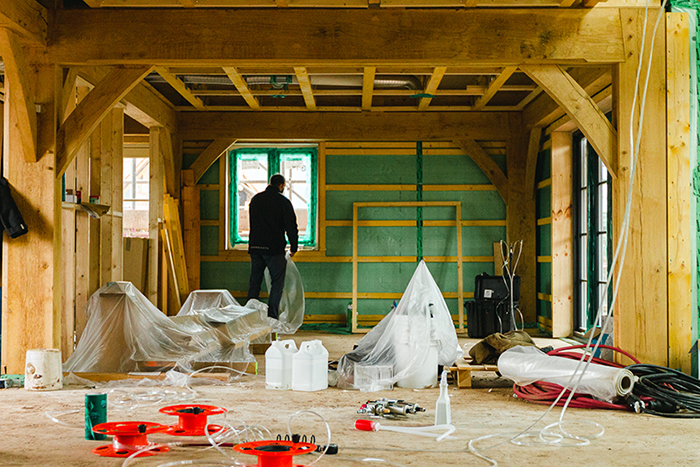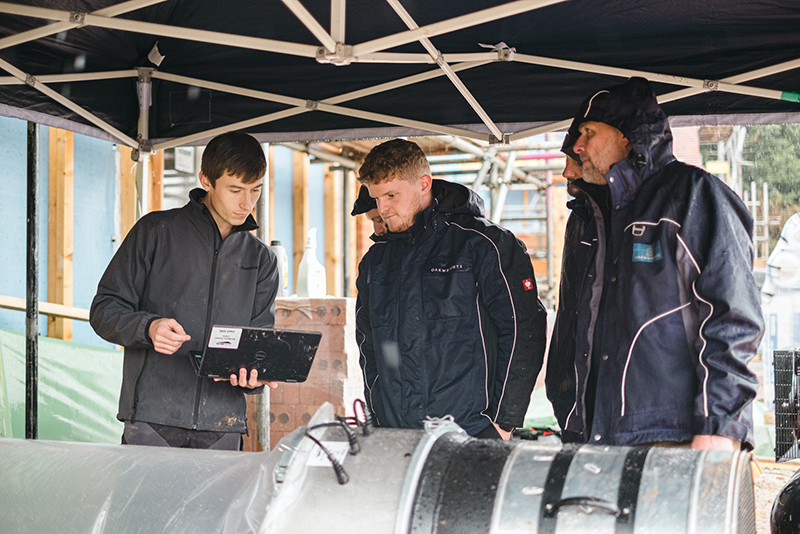
Hugh Franklin, head of AeroBarrier UK, explains why technology holds the key to meeting ambitious decarbonisation targets in Scotland’s housing sector
SCOTLAND’S focus on energy-efficient regulations has placed it as the front-runner for sustainable building regulations in the UK. The question is, how to guarantee success?
According to the newest iteration of Scottish Building Regulations Section 6, implemented on 5 June 2023, all new domestic dwellings must be tested for air tightness to CIBSE TM23, an approved standard across all home nations. Scottish regulations are stricter than UK regulations, stating a maximum air loss figure of 7m3/hr/m2, compared to 10m3/hr/m2 in the UK.
From December 2024, all new housing in Scotland will be built to the highest energy efficiency standards, a Scottish Passivhaus equivalent. A Passivhaus building uses around 75% less energy than is standard practice for a UK new build, significantly reducing energy costs and improving the quality of living for residents.

However, a focus on new builds ignores the existing housing stock. Just under half of the dwellings in Scotland fail to meet energy efficiency standards of an EPC rating of C or above, according to the latest Scottish House Condition Survey.
This is a problem waiting to happen, as all homes will require an EPC rating of C or higher at the point of sale or change of tenancy by the backstop date of 2033 – with the privately rented sector having an earlier backstop of 2028.
It’s not just energy performance that is causing concern. In Edinburgh alone, cases of dampness in social rented homes have increased from 122 in 2019 to 1,215 in 2022 according to local council data.
Improving air tightness can help reduce moisture permeation that causes health issues for residents. The government is also decarbonising Scottish heating systems by phasing out fossil fuel boilers in off-gas properties from 2025 and in on-gas areas from 2030.
Guaranteeing results
It is hard to see the true impact of these regulations and challenges on Scotland’s new and existing housing stock. Doubters will question the cost and how effective air tightness solutions and testing can be carried out in every home. Technology is the answer.
Traditionally construction businesses had to fill holes with caulk, tape and foam. This manual, costly and time-consuming process cannot guarantee a specific level of air tightness, even if it is carried out by highly skilled people. Holes invisible to the naked eye can significantly impact the air tightness of the property, leading to a home that does not comply with the new Passivhaus equivalent regulations that Scotland is introducing.

Industry figures show 231,000 people in Scotland are currently employed in construction, but an additional 3,910 more a year are needed to meet expected demand. Upskilling existing construction workers so they can use more sustainable and efficient technologies and products is key to hitting net zero targets.
Encouraging the younger generations into a sustainable construction career will also help tackle the ageing construction workforce and push the industry towards a sustainable future.
Finding a solution
Meeting Scotland’s ambitious housing and decarbonisation targets will not be possible without collaborative, proactive action from the government, industry and innovators. Scotland’s net zero emissions target date of 2045 is ahead of many other countries, including the UK, whose target is to reach net zero by 2050. There is also an interim target of a 75% reduction in emissions by 2030, relative to 1990 levels.
One solution that can guarantee air tightness levels and meet these net zero targets is AeroBarrier. AeroBarrierUK pressurises a property and uses a waterborne, non-toxic mist of particles to plug 100% of all unwanted gaps.

The sealant mist is drawn into visible and invisible gaps where it solidifies to create a seal and improve air tightness in just a few hours.
An operator with a laptop controls the level of air tightness seal required by the contractor so they can achieve – when ventilation methods are considered – the required certification and prove compliance with Scottish building regulations.
AeroBarrier has already been widely used across 35,000 homes, hospitals, schools and public buildings in the US, Canada and the Middle East. There’s no reason why it can’t work for Scotland’s developers and self-builders.
Scotland and its building regulations are paving the way for the UK to consider a more sustainable future. The Scottish Government need to enforce their vision, set clear goals and provide guidance about how people can use existing innovations, like AeroBarrier, to achieve the regulations they are implementing.
• Learn more about AeroBarrierUK on the website https://www.aerobarrieruk.co.uk/








